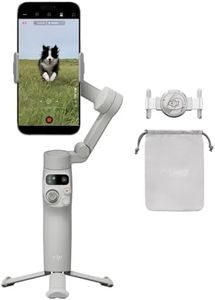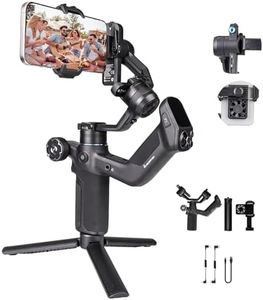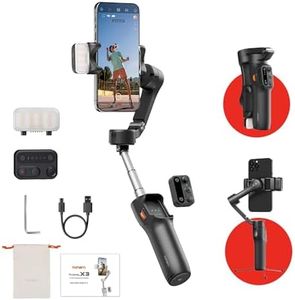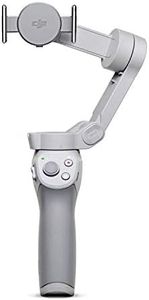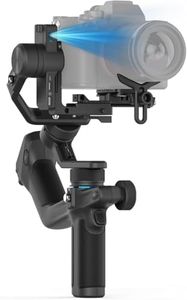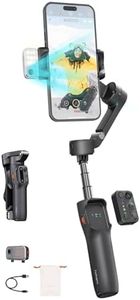We Use CookiesWe use cookies to enhance the security, performance,
functionality and for analytical and promotional activities. By continuing to browse this site you
are agreeing to our privacy policy
10 Best Smartphone Gimbal
From leading brands and best sellers available on the web.Buying Guide for the Best Smartphone Gimbal
Choosing a smartphone gimbal can make a big difference in how smooth and professional your videos look. A gimbal stabilizes your phone and helps counteract unwanted movements when you’re filming, making it a favorite tool for vloggers, travelers, and anyone who wants better video quality from their phone. Before you decide, think about where and how you will use your gimbal—like during travel, live streams, or action shots—and weigh which features are most relevant for your needs.Stabilization AxisThe stabilization axis refers to how many directions the gimbal can smooth out your movements. Most smartphone gimbals are either 2-axis or 3-axis. A 2-axis gimbal stabilizes tilt and roll (up-down and side-to-side), while a 3-axis gimbal also stabilizes pan (turning left and right). Generally, a 3-axis option gives the smoothest results and is best for dynamic filming, like walking or running. If you only need simple stabilization, such as for stationary shooting or slow panning, a 2-axis might suffice.
Payload CapacityPayload capacity describes how much weight the gimbal motors can handle. This is important because if your phone is too heavy or if you plan to attach additional accessories like lens attachments or microphones, you’ll need a gimbal with higher capacity. For most users with standard-sized smartphones, almost any modern gimbal will work, but if you have a large or heavy phone, or use extra gear, double-check the specs to ensure your gimbal can support the total weight.
Battery LifeBattery life tells you how long the gimbal can operate on a single charge. Battery life varies widely, with some lasting just a few hours and others running for more than 12 hours. For occasional filming or short clips, a shorter battery life may be enough. If you plan to film for long periods—like at events or while traveling—a longer battery life will be much more convenient and prevent sudden interruptions.
Portability and SizePortability is all about how easy it is to carry your gimbal around. Some models fold down to a very compact size, while others are bulkier. If you want to carry the gimbal in a small bag, backpack, or even a large pocket, look for foldable or lightweight models. If you don’t mind carrying more gear and prioritize stability, size and weight might matter less.
Controls and App IntegrationControls and app integration refer to how you operate the gimbal and interact with its extra features. Some gimbals have simple manual controls, while others offer advanced features like object tracking, time-lapse, gesture control, and face tracking through a companion app. If you want creative shooting modes and easy ways to adjust settings, consider how robust and user-friendly the gimbal’s app and onboard controls are. For straightforward manual stabilization, simpler controls may suffice.
Mounting Options and AttachmentsMounting options mean how easily you can attach your phone and whether you can add accessories like tripods, lights, or microphones. Some gimbals have standard tripod threads at the bottom or accessory mounts on the side. If you plan to use your gimbal for more than basic handheld filming—such as stationary tripod shots or vlogging setups—pay attention to the number and type of attachment points offered.
Balancing SystemThe balancing system is about how easy it is to set up your phone on the gimbal so it stays level. Some gimbals have automatic balancing that makes setup effortless, while others require manual adjustments. If you want a quick and hassle-free start every time, look for models with easier or automatic balancing. For those who are patient or don’t mind spending more time setting up, manual systems might be fine.

